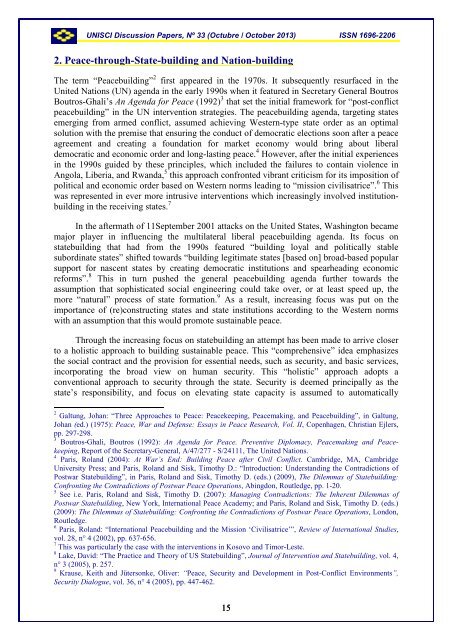UNISCI - Universidad Complutense de Madrid
UNISCI - Universidad Complutense de Madrid
UNISCI - Universidad Complutense de Madrid
You also want an ePaper? Increase the reach of your titles
YUMPU automatically turns print PDFs into web optimized ePapers that Google loves.
<strong>UNISCI</strong> Discussion Papers, Nº 33 (Octubre / October 2013) ISSN 1696-22062. Peace-through-State-building and Nation-buildingThe term “Peacebuilding” 2 first appeared in the 1970s. It subsequently resurfaced in theUnited Nations (UN) agenda in the early 1990s when it featured in Secretary General BoutrosBoutros-Ghali’s An Agenda for Peace (1992) 3 that set the initial framework for “post-conflictpeacebuilding” in the UN intervention strategies. The peacebuilding agenda, targeting statesemerging from armed conflict, assumed achieving Western-type state or<strong>de</strong>r as an optimalsolution with the premise that ensuring the conduct of <strong>de</strong>mocratic elections soon after a peaceagreement and creating a foundation for market economy would bring about liberal<strong>de</strong>mocratic and economic or<strong>de</strong>r and long-lasting peace. 4 However, after the initial experiencesin the 1990s gui<strong>de</strong>d by these principles, which inclu<strong>de</strong>d the failures to contain violence inAngola, Liberia, and Rwanda, 5 this approach confronted vibrant criticism for its imposition ofpolitical and economic or<strong>de</strong>r based on Western norms leading to “mission civilisatrice”. 6 Thiswas represented in ever more intrusive interventions which increasingly involved institutionbuildingin the receiving states. 7In the aftermath of 11September 2001 attacks on the United States, Washington becamemajor player in influencing the multilateral liberal peacebuilding agenda. Its focus onstatebuilding that had from the 1990s featured “building loyal and politically stablesubordinate states” shifted towards “building legitimate states [based on] broad-based popularsupport for nascent states by creating <strong>de</strong>mocratic institutions and spearheading economicreforms”. 8 This in turn pushed the general peacebuilding agenda further towards theassumption that sophisticated social engineering could take over, or at least speed up, themore “natural” process of state formation. 9 As a result, increasing focus was put on theimportance of (re)constructing states and state institutions according to the Western normswith an assumption that this would promote sustainable peace.Through the increasing focus on statebuilding an attempt has been ma<strong>de</strong> to arrive closerto a holistic approach to building sustainable peace. This “comprehensive” i<strong>de</strong>a emphasizesthe social contract and the provision for essential needs, such as security, and basic services,incorporating the broad view on human security. This “holistic” approach adopts aconventional approach to security through the state. Security is <strong>de</strong>emed principally as thestate’s responsibility, and focus on elevating state capacity is assumed to automatically2 Galtung, Johan: “Three Approaches to Peace: Peacekeeping, Peacemaking, and Peacebuilding”, in Galtung,Johan (ed.) (1975): Peace, War and Defense: Essays in Peace Research, Vol. II, Copenhagen, Christian Ejlers,pp. 297-298.3 Boutros-Ghali, Boutros (1992): An Agenda for Peace. Preventive Diplomacy, Peacemaking and Peacekeeping,Report of the Secretary-General, A/47/277 - S/24111, The United Nations.4 Paris, Roland (2004): At War’s End: Building Peace after Civil Conflict. Cambridge, MA, CambridgeUniversity Press; and Paris, Roland and Sisk, Timothy D.: “Introduction: Un<strong>de</strong>rstanding the Contradictions ofPostwar Statebuilding”, in Paris, Roland and Sisk, Timothy D. (eds.) (2009), The Dilemmas of Statebuilding:Confronting the Contradictions of Postwar Peace Operations, Abingdon, Routledge, pp. 1-20.5 See i.e. Paris, Roland and Sisk, Timothy D. (2007): Managing Contradictions: The Inherent Dilemmas ofPostwar Statebuilding, New York, International Peace Aca<strong>de</strong>my; and Paris, Roland and Sisk, Timothy D. (eds.)(2009): The Dilemmas of Statebuilding: Confronting the Contradictions of Postwar Peace Operations, London,Routledge.6 Paris, Roland: “International Peacebuilding and the Mission ‘Civilisatrice’”, Review of International Studies,vol. 28, n° 4 (2002), pp. 637-656.7 This was particularly the case with the interventions in Kosovo and Timor-Leste.8 Lake, David: “The Practice and Theory of US Statebuilding”, Journal of Intervention and Statebuilding, vol. 4,n° 3 (2005), p. 257.9 Krause, Keith and Jütersonke, Oliver: “Peace, Security and Development in Post-Conflict Environments”,Security Dialogue, vol. 36, n° 4 (2005), pp. 447-462.15
















